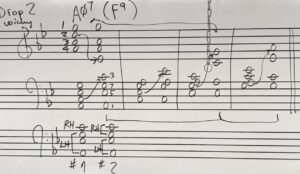I sit across the table from him. He stands, leaning towards me, his hands grip the back of his chair. The night is gathering with birds tracing the colored clouds. “You must,” he is emphatic, “Study the history and theory of music before you begin to create your own music. Only when you know where you came from can you know where you are going.”
I smile. The old canon – a powerful system of beliefs. I have wrestled with them before, and have found, after a fifty-year career of writing music, that they are not true for me.
The canon insists that one must study the classics before creating; years of studying performance, harmony, counterpoint, set-theory, analysis and orchestration before pencil hits the paper. The canon maintains that understanding music history is an essential, and without it the artist gropes in the dark in a vain attempt to reinvent the wheel. The canon implies an order – one must do A before B. It reinforces that personal creativity is not trustworthy unless it is in an old container: it is not credible without context. In other words, one must be coupled to the past to make authentic, groundbreaking art.
performance, harmony, counterpoint, set-theory, analysis and orchestration before pencil hits the paper. The canon maintains that understanding music history is an essential, and without it the artist gropes in the dark in a vain attempt to reinvent the wheel. The canon implies an order – one must do A before B. It reinforces that personal creativity is not trustworthy unless it is in an old container: it is not credible without context. In other words, one must be coupled to the past to make authentic, groundbreaking art.
I disagree, differ, object, dissent, argue, debate, and nonconcur. I protest. My experience is there are multiple paths to creativity and all of them include the word “Yes.”
I am interested in a personal ownership that grows out of doing. I support experiencing writing music before too much comparison. In the initial stage, I want everyone to compose the way they painted in kindergarten. Hardly knowing how to hold a paint brush, they work with abandon and in full confidence of their creative abilities.
a personal ownership that grows out of doing. I support experiencing writing music before too much comparison. In the initial stage, I want everyone to compose the way they painted in kindergarten. Hardly knowing how to hold a paint brush, they work with abandon and in full confidence of their creative abilities.
Playing an instrument is key. It combines the kinetic, aural and visual learning in one practice – a kind of intimate study of music – fingering each note, breathing with the phrase – a mind-body experience.
And of course, the “guts” of music – the harmony and theory, but in context. I wonder what this study tells us about the composers of that time period, and how is it different that our own. I remind myself that the ‘great’ composers that we study, listen to and venerate have been curated by excluding much of musical culture or even composers.
But mostly, I was always on guard to protect creativity – mine and my students. I believe critical thinking rather than criticism – what worked, what didn’t work, what could I do better. This is a conversation between myself and the work, no from an outside source.
FOLLOW TINA DAVIDSON Facebook Instagram
Featured Work
PAPER, GLASS, STRING & WOOD
A side-by-side work to perform with student string musicians or string orchestra
This beautiful four-movement work was created so that young or amateur musicians have the opportunity to rehearse and perform with professional string performers.
1. Paper: https://www.youtube.com/watch?v=nHfCz2qbucY
3. String: https://www.youtube.com/watch?v=GNOBbt1EHrQ
4: Wood: https://www.youtube.com/watch?v=1_XSku4IpoU
Sign up for Davidson’s Newsletter
